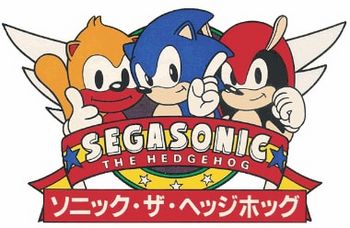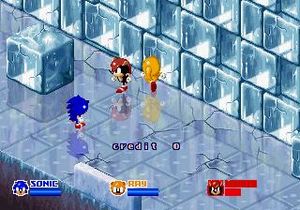SegaSonic the Hedgehog facts for kids
Quick facts for kids SegaSonic the Hedgehog |
|
|---|---|
 |
|
| Developer(s) | Sega AM3 |
| Publisher(s) | Sega |
| Director(s) | Tomosuke Tsuda |
| Composer(s) | Hiroshi Kawaguchi Keitaro Hanada Naoki Tokiwa |
| Series | Sonic the Hedgehog |
| Platform(s) | Arcade |
| Release date(s) |
|
| Genre(s) | Platform |
| Mode(s) | Single-player, multiplayer |
| Arcade system | Sega System 32 |
SegaSonic the Hedgehog is a fun arcade game from 1993. It's part of the famous Sonic the Hedgehog series by Sega. In this game, you get to play as Sonic, his friend Mighty the Armadillo, and Ray the Flying Squirrel. They've been kidnapped by the bad guy, Doctor Eggman, and are stuck on his island! Your mission is to help them escape as fast as you can.
The game looks like you're seeing the action from a slight angle, which is called an isometric view. You control the characters using a special ball called a trackball. You roll the trackball to move them around, dodge tricky obstacles, and collect shiny rings.
SegaSonic the Hedgehog was made by Sega's arcade team, Sega AM3. It was inspired by an older game called Marble Madness. The game came out in Japanese arcades in 1993. It has not been released again since then. There were plans to bring it to the 32X game system, but that never happened. It was also supposed to be in the Sonic collection game Sonic Gems Collection in 2005. However, it was removed because it was too hard to make the trackball controls work with a regular game controller.
When it first came out, SegaSonic the Hedgehog got great reviews from magazines like Electronic Gaming Monthly and Computer and Video Games. People really liked its graphics and how it played. This game was also the first time we met Mighty the Armadillo and Ray the Flying Squirrel. They have appeared in the Sonic games a few times since then.
How to Play SegaSonic the Hedgehog
SegaSonic the Hedgehog is a platform game. It plays a bit like the classic game Marble Madness. You can control three characters: Sonic the Hedgehog, Mighty the Armadillo, and Ray the Flying Squirrel. One player can control them, or up to three friends can play together at the same time. The story begins when the evil Doctor Eggman traps them on his island. They decide to work together to escape. They must avoid many dangers and traps to reach Eggman in his base, which is called the Eggman Tower.
The game has seven different levels. Your goal is to finish each level as quickly as possible. You use a trackball to control how fast your character moves and in what direction. The game shows you the action from an isometric view. There's also a button you can press to make your character jump and do a Spin Attack.
Each character has a health bar. If you fall into traps, your health bar goes down. If it empties, you lose a life. You can get your health back by collecting rings. Rings are scattered around the levels or hidden inside obstacles and enemies. If you collect a lot of rings in a level, you get bonus rings to use later in the game. When you finally reach Eggman at the end, he presses a button that makes the island blow up! But don't worry, Sonic and his friends manage to escape safely, while Eggman is left floating in the sea.
Making the Game
Before SegaSonic the Hedgehog, Sega tried to make two other Sonic the Hedgehog arcade games. But those games were never released. By May 1993, a new Sonic arcade game was being made. SegaSonic the Hedgehog was developed by Sega AM3. This is a special team within Sega that makes games for arcade cabinets. They also got help from Sonic Team. This game is one of four Sonic arcade games that use the SegaSonic name.
A designer named Manabu Kusunoki said that the idea for using trackball controls came from someone on the team who loved Marble Madness. They thought a trackball would work well with Sonic's fast gameplay. The game uses a special computer board called a Sega System 32 motherboard. This board allows for the multiplayer option and helps create the unique isometric graphics.
The game introduced two new characters: Ray the Flying Squirrel and Mighty the Armadillo. Manabu Kusunoki designed both of them. He picked these animals because he thought they would move similarly to Sonic. He also liked that, like hedgehogs, they were not very common animals. Mighty was probably based on an early idea for Sonic himself! The game also has voice acting. Takeshi Kusao voices Sonic, Hinako Kanamaru voices Ray, Yusuke Numata voices Mighty, and Masaharu Satō voices Eggman.
The game was first going to be called just Sonic the Hedgehog. But the name was changed to SegaSonic because Sega had a problem with the "Sonic" trademark during the game's creation. SegaSonic the Hedgehog was shown at big events like the Summer International Consumer Electronics Show in 1993 and the Amusement Machine Show in 1993. It was released in Japanese arcades later that year. We don't know for sure if the game was released outside of Japan. However, people who look at game files found English words and pictures of Eggman from the American Sonic the Hedgehog TV show. This suggests that Sega might have planned to release it in American arcades to help promote the TV series.
SegaSonic the Hedgehog has never been released again since its arcade debut. There were talks about making a version for the 32X, which was an add-on for the Sega Genesis. This was reported in late 1994. Sonic co-creator Yuji Naka said that they thought about putting the game in the 2005 collection Sonic Gems Collection. This collection was for the GameCube and PlayStation 2. But they couldn't include it because it was too hard to make the trackball controls work on a regular gamepad.
In 2011, Ken Balough, a brand manager for Sega, said that not many people were asking for the game to be re-released. He thought this was because it was not released outside Japan. In 2020, Yosuke Okunari from Sega mentioned that SegaSonic The Hedgehog might be ported if other games in the Sega Ages series did well.
Images for kids
See also
 In Spanish: SegaSonic the Hedgehog para niños
In Spanish: SegaSonic the Hedgehog para niños



